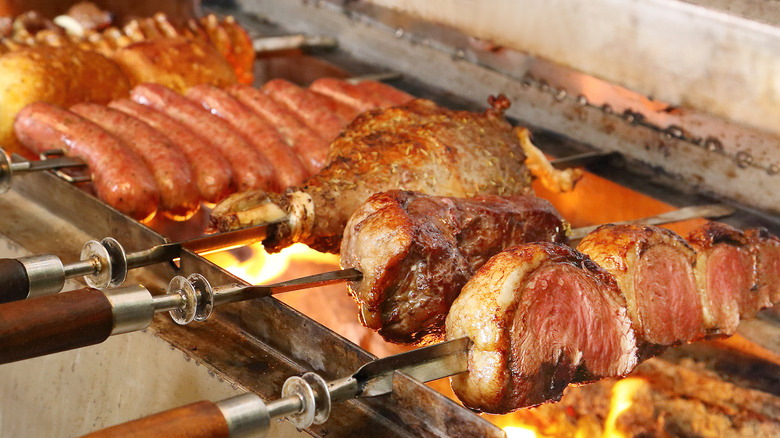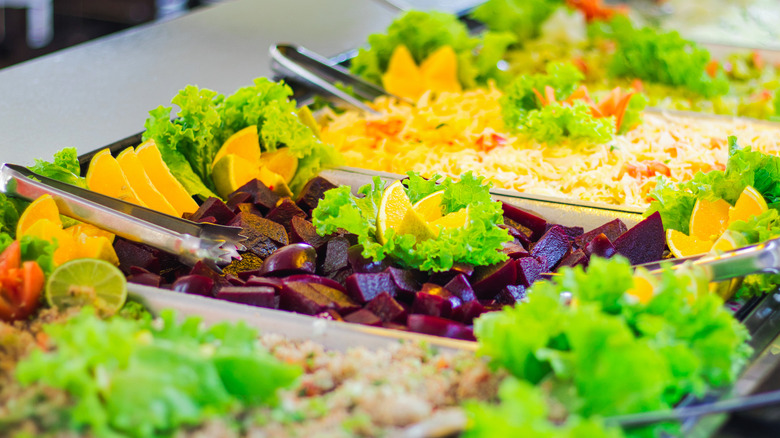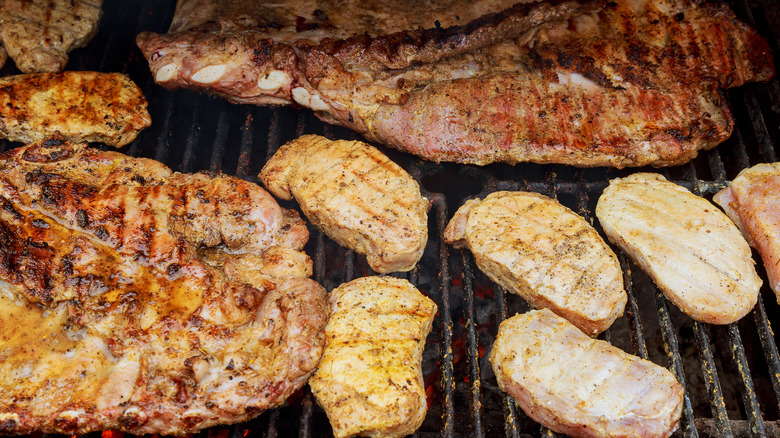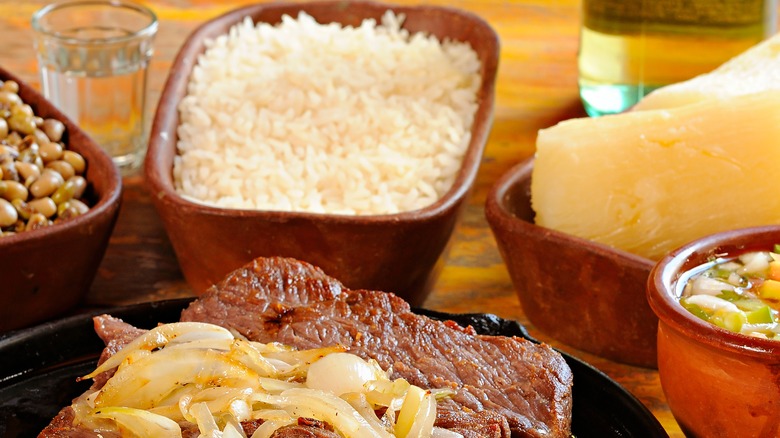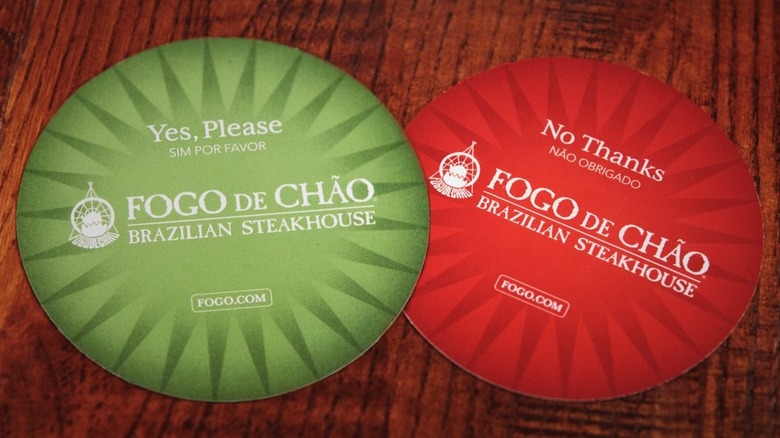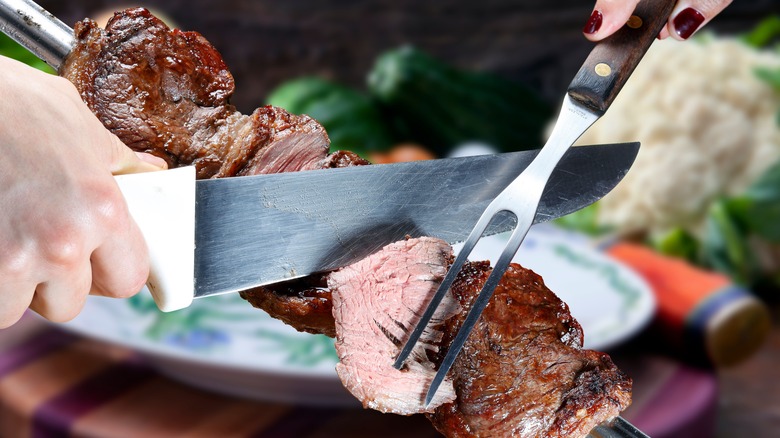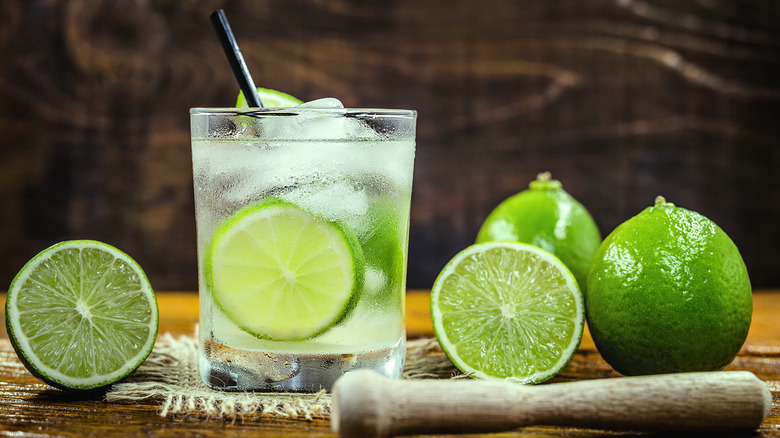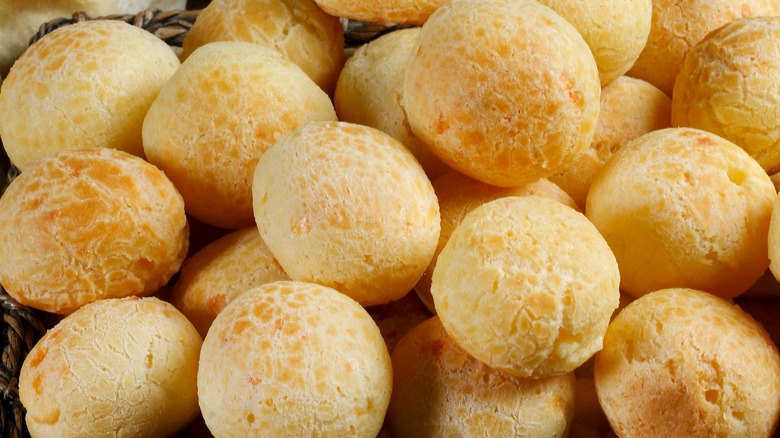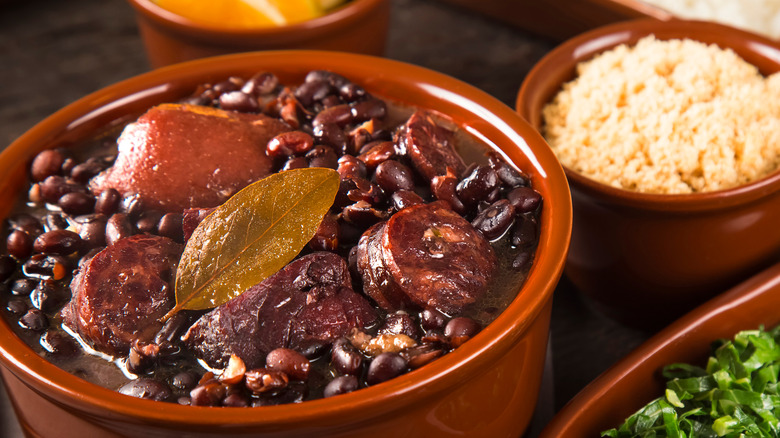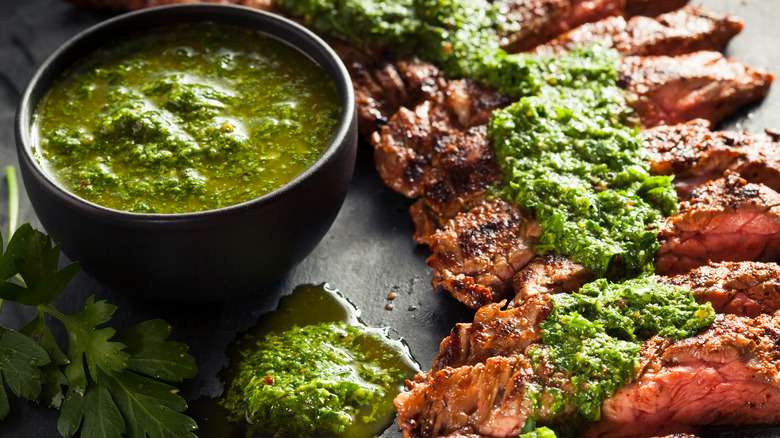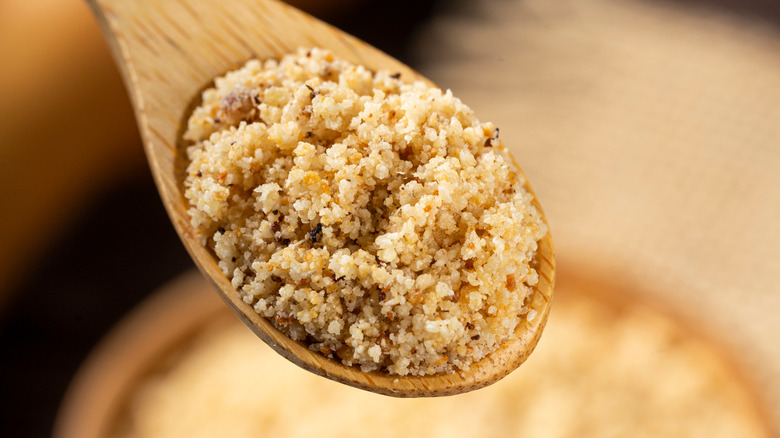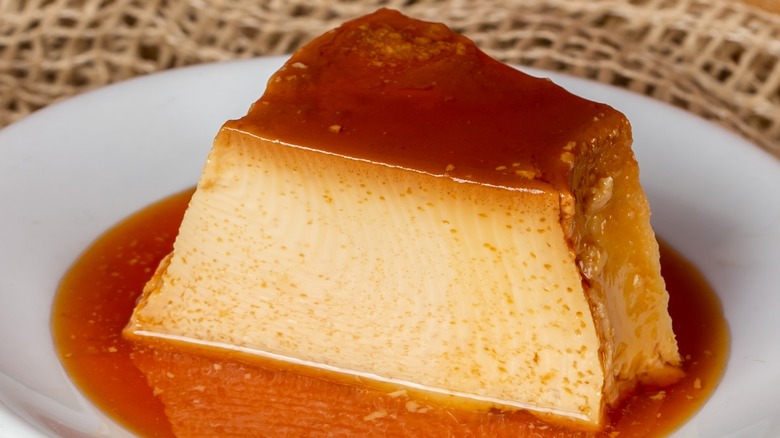12 Mistakes Everyone Makes When Eating At A Brazilian Steakhouse
Everybody loves a trip to their favorite steakhouse. (We even know some vegans who will go, just to enjoy all the incredible sides.) But the star of any steakhouse, of course, is all that grilled meat — succulent juicy cuts of beef, plus amazing pork and chicken, all cooked to perfection and meant to be savored in a group setting. And while steakhouses are great on their own, Brazilian steakhouses (which are also sometimes known by their Brazilian name as "churrascarias") take that level of enjoyment to a whole new space. After all, where else in the world can you go where the specialty is all-you-can-eat meat?
But a word of caution: Before you plan any trip to a Brazilian steakhouse, there are a few things you should know. After all, you are visiting a type of restaurant created in a land not too many of us have had the chance to visit or truly enjoy. The menu in these restaurants is packed with local favorites most Americans aren't familiar with, and there are customs as well you may or may not be aware of. In other words, your dining experience could be rife with mistakes that will either limit your night or bring it crashing down altogether!
Fear not. We're here to help. Read on for our tips. We'll soon have you dining like you were born in Rio — and getting the absolute most out of the meat eater's mecca known as the Brazilian steakhouse.
Never fill up on appetizers at a Brazilian steakhouse
Whether you're celebrating a big occasion or just out with friends and family, eating at a Brazilian steakhouse is a special experience — and everybody wants to make the most of it. In most restaurants, that generally means a round of two of amazing shared appetizers to kick off the meal and get the festivities started.
But when you go to a churrascaria, you need a different strategy. Even though your meal likely includes an unlimited selection of mouth-watering potato and pasta salads, coleslaws, tomato and onion salads, a variety of bean salads plus salads made with hearts of palm or beets, don't make the common mistake of filling up at the salad bar before you've even gotten to the main attraction — all those decadent grilled meats! As the saying often goes, "The meat is unlimited, but your stomach is not!"
Even though all these salads are likely very good, now is not the time to consider dishes you can get at other places or that you eat all the time at home. Leave those for the inexperienced diners. Instead, pick one or two salads or sides to focus on. They should be unique flavors or contain ingredients you don't often get to enjoy elsewhere. Take small portions of each — and enjoy them. But unless you absolutely have to have more, no going back for seconds. Save room for all that deliciousness that is yet to come — the meat!
Be sure to sample all of the meats
The churrascaria is a meat eater's paradise, filled with seemingly endless amounts of all of the most delicious meats you can think of. From tender filet mignon to juicy sirloin, these restaurants serve steaks of every type and every doneness imaginable. Make sure you try it all!
Starting with beef, try a cut of meat known as picanha (pronounced pee-kahn-yah). Sourced from the rump of the cow, picanha is the most famous steak in Brazilian cuisine. It's moist and juicy and usually grilled with a salty spice rub that perfectly compliments its savory umami flavor. It also usually comes with a thin layer of fat, which renders and caramelizes in the heat of the grill, becoming melt-in-your-mouth tender. In addition to picanha, keep an eye out for it's leaner cousin alcatra, which is usually served medium-rare, fraldinha (or flank steak), and costela (beef ribs), all of which are Brazilian steakhouse faves.
When it comes to chicken, you'll see the legs, thighs, wings, and breasts you would expect. But you should also watch out for small skewers of coração de frango, or chicken hearts, which are incredibly popular in Brazil. Chicken wrapped in bacon is another regional favorite. And not to be outdone, most churrascarias also serve an incredible selection of grilled pork ribs, pork loin, pork belly, ham, and bacon-wrapped pork tenderloin plus grilled salmon, grilled seafood skewers, and grilled and fried shrimp. So much meat, so little time!
Avoid overloading on carbs
We already warned you to be wary of the salad bar when dining in a Brazilian steakhouse. But that's not the only place where unwanted and filling carbs can hide. To maximize your dining experience — and avoid all those sources of carbohydrates that can fill you up too early — you need to watch out for a number of different sides that might sneak their way onto your plate.
The biggest offenders are two of Brazil's favorite foods: rice and beans. Brazilian steakhouses routinely offer plain white rice or beef-flavored "arroz carreteiro" as a side with their grilled meats. Both are delicious, but they are less unique than many of the other foods these churrascarias serve up, so it's best to stick with small portions if you have to have them. Also keep an eye out for polenta, fried yuca, fried cassava root ("mandioca frita"), and the common french fry (which Brazilians call "batata frita").
Again, all are good — but if you want to make the most of your meal, remember that if you fill up on beans, rice, and other carbs, that's less room you have available for the rest of your meal.
Don't misuse the table card
For many, the experience of eating at a Brazilian steakhouse is unlike any other. This is a meal meant to be savored and enjoyed. And one of the biggest aspects to not only enjoying your meal, but also getting the most out of it, is knowing and understanding how to use your table card or place card — an incredible feature unique to Brazilian steakhouses.
How does the system work? It's basically a traffic signal for your server. Every person in the restaurant gets one, and they all mean the same thing. Green is "go" — meaning you are hungry and want to be served. Servers will see the card and stop at your table as they work their way through the dining room, offering various cuts of meat fresh from the grill. As long as your card is turned to the green side, the meat continues to be delivered like some kind of marvelous, never-ending carnivore dream.
Feeling full? Now's the time to flip your card over to the red side. This means "stop." And that's exactly what happens — the meat stops. Others at your table may continue eating, depending on their hunger level, but the red signifies you are sitting out for a few minutes, or maybe you are done with your meal entirely. Get your second wind? Just flip the card back to green, and here comes more of that incredible meat! The Brazilians have developed an effective system. What's not to love?
Repeat after us: Pacing is key!
Nobody goes to a Brazilian steakhouse to watch what they eat or count calories. This exciting dining experience is meant to be indulgent — that's part of the charm and is one of the main reasons churrascarias are so popular around the world. That said, you also don't want to leave your dining experience so stuffed you need to immediately crash into a bed and nap off your meal like we all do after Thanksgiving. Nor do you want to leave the steakhouse sick to your stomach from simply eating too much. That's why pacing is so important!
Many first-time diners at a churrascaria make the mistake of eating too quickly, which can not only leave you bloated and in pain but also keep you from enjoying your dining experience. Remember: There's a serious lag between the time food enters your stomach and how long it takes your brain to recognize you are full. The faster you eat, the greater the delay becomes.
Instead of rushing, enjoy the environment. Take time during your meal to chat with the people you are dining with. Savor the experience. Meals at Brazilian steakhouses are not fast food, and they aren't meant to happen quickly. Pause while eating and take a quick break. Chew your food slowly, and take in the flavors. This not only improves your overall dining experience, but it also aids in digestion and helps your body to process the food, making room for more.
Skip your favorite beer and order a caipirinha
You could go to a Brazilian steakhouse and ask for a margarita or a daiquiri — or your favorite go-to beer — but if you really want to experience what a day in the life of South America's biggest country is really like, you have to order a caipirinha, one of Brazil's most popular national drinks.
Crafted from a blend of cachaça, or Brazilian rum (which is distilled from sugar cane), plus lime, sugar, and ice, a caipirinha is the perfect compliment to any steakhouse meal. The sweet and sour drink carries a potent flavor punch on its own and is ideal when combined with the earthy, smoky flavors of grilled meat. Don't like lime? No problem. As with most other tropical mixed drinks, caipirinhas are generally available in a variety of other flavors, including passion fruit, pineapple, or strawberry. For a slightly less sweet version of the drink, ask your bartender for what's known as a caipiroska instead. This cousin to the caipirinha is made with vodka instead of cachaça.
Order a pitcher of the caipirinha or caipiroska of your choice for the table, and when everyone has their glasses raised, make like a local and offer the typical Brazilian toast of "Saúde!" which translates as "to your health!" in English.
Even bread haters need to try the pão de queijo
France has the baguette. India has naan. The Middle East has the pita. And in Brazil, the bread of choice is what's known as pão de queijo, which translates to "cheese bread." Sold in bakeries, cafes, and snack bars — as well as steakhouses — throughout the country, pão de queijo is made with cassava flour. Instead of slices, the naturally gluten-free pão de queijo is served in small rounds that are about the size of a large meatball. They pack a slightly salty taste, and they're chewy, pillowy soft, and usually eaten warm, straight out of the oven.
While most pão de queijo is stuffed with a pocket of gooey melted Parmesan, there are other varieties out there worth investigating, including bread made with cheddar or mozzarella. Sometimes fresh herbs such as rosemary or oregano are also added to the dough for even more flavor.
If you're in a steakhouse with an extensive bakery menu, look for a couple other great Brazilian specialties worth trying. Pão de alho is a type of garlic bread similar to the Italian slices we all eat with pasta — it too sometimes contains fresh herbs like oregano or rosemary. Bolo de milho is another baked favorite. This variation on cornbread is sweetened with coconut milk, giving the cornmeal a unique tropical sweet flavor unlike anything we typically eat here in the states.
Not trying the feijoada is a huge mistake
Who goes to a steakhouse and orders a stew? Millions of Brazilians, that's who. And you will too if you really want to experience some of the best of what Brazilian cuisine has to offer. Feijoada (pronounced fay-jow-aa-duh) is widely regarded as the national dish of Brazil. This hearty stew is generally made with moist, creamy black beans; a variety of diced up meats including pork ribs, pork belly, bacon, and sausage; vegetables (onions, garlic, bell peppers, and tomatoes); plus a blend of spices like bay leaves, cumin, black pepper, and salt. The stew is cooked over the stove for hours until all the ingredients are tender. It's then served over a bed of rice, which helps to soak up all those succulent juices.
Believed to have originated in the 16th century, feijoada was created by the country's poor and enslaved. The dish is based around leftovers and scraps of the meat that others wouldn't eat — and that were then turned into marvelous stews. Over time, the dish gained widespread popularity throughout all classes, and it has been a staple of Brazilian cuisine ever since.
And don't think you shouldn't order feijoada just because it isn't cold out. It may be a stew, but this aromatic, robust and comforting mixture of meat and beans is popular throughout Brazil, regardless of the season. Locals even eat it in the evening after a day at the Copacabana beach!
Be sure to order the linguiça
Brazilian sausage, also known as "linguiça" (ling-gwee-suh), is a staple of Brazilian cuisine and an essential part of the churrasco experience. It's also an incredibly satisfying and delectable treat most Americans don't get to explore that often.
Linguiça comes in a variety of types. There's linguiça de porco, or pork sausage, which is generally flavored with garlic and paprika. Its spicier big brother is called linguiça calabresa, which is a mixture of pork and beef as well as chili pepper and other spices. There are also types of Brazilian sausage made with chicken (linguiça de frango) and even wild boar (linguiça de javali). Linguiça defumada is another Brazilian favorite, which is smoked and can have a very distinct hickory or mesquite campfire scent and flavor.
Depending on the steakhouse, you may also get the chance to experience a number of other popular Brazilian sausages besides linguiça. There's also chouriço, which is similar to Spanish chorizo; morcela, which is a type of blood sausage made with pork blood, rice, and spices; salsicha, which is similar to a hot dog or frankfurter; and toscana, which comes from the south of Brazil and is a pork sausage famous for its sweet and spicy punch that comes from a blend of garlic and fennel seeds.
Meat loves a good sauce — be sure to sample a variety
When you are surrounded by plate after plate of incredible fried and grilled meat, it can be tempting to want to keep things simple and just stick to minimalist seasonings like salt and pepper. But If you're dining at a Brazilian steakhouse, don't make the mistake of skipping out on those amazing sauces. They're an incredible compliment to all those savory, caramelized umami meat flavors.
Whether they're sweet, spicy, or zesty and acidic, the sauces served in most churrascarias are also an essential part of the Brazilian steakhouse dining experience. One must-try sauce is the house-made chimichurri. This bright green sauce is generally a mixture of parsley, garlic, olive oil, vinegar, and red pepper flakes and is perfect for adding a tangy, herbal kick to almost any meat. Pimenta malagueta — which is made from small, spicy chile peppers plus vinegar, salt, garlic, onion, and other spices — is another essential sauce to try, especially for anyone who loves a bit of heat with their steak or sausage. Finally, don't forget the molho à campanha, which is made from diced tomatoes, onions, bell peppers, and cilantro. This sauce is a bit like American relish and is a great way to add a fresh and slightly acidic flavor to charred meat. It also helps to cut through the meat's smoky richness.
Don't forget to ask for some farofa
Farofa, you say — what's that? This beloved Brazilian side dish is a thick, crumbly mixture of toasted cassava flour, spices, plus butter or oil from the various meats being cooked in the kitchen. All of the ingredients are mixed together until the fat has been absorbed by the flour, creating a hearty, flavorful powder. To eat it, you simply sprinkle as little or as much as you want over whatever meat you are eating. It's especially tasty on feijoada, grilled fish, and picanha. The toasty, nutty flavor of the farofa is a perfect compliment to the rich, savory flavor of the meat — and it also adds an incredibly satisfying crunch to all that tender and juicy steak, chicken, and pork.
Farofa is typically served in a communal bowl for families to share, but it can also come in individual servings depending on the restaurant. The dish originated in Africa and was brought to Brazil where it has since become a staple of the local cuisine. Farofa is made regularly in churrascarias. Be sure to ask your server if they offer different varieties. One version comes with bacon, onions, and herbs such as parsley, cilantro, rosemary, and sage. Delicioso!
The biggest Brazilian steakhouse mistake you can make? Not saving room for dessert
Yes, you came for the meat and all those savory grilled dishes, but dessert is also a crucial part of the Brazilian dining experience and should never be overlooked. Besides providing an incredible contrast to all those rich and savory steaks and sausages you've downed, Brazilian desserts have another great thing going for them: They're unique and tend to be a must-try for any true foodie.
Four of our favorites include pudim de leite, which is a silky caramel flan made from milk, sugar, eggs, and condensed milk; quindim, which is a creamy, sticky coconut custard; bolo de rolo, a thin sponge cake coated with guava paste or dulce de leche and then served in rolled slices; and the wonderfully named Romeo e Julieta, which is essentially a layer of guava paste topped with a layer of a mild white cheese called Minas cheese for the perfect pairing of sweet and fruity plus salty and creamy.
Too full for an entire dessert? Ask if the restaurant has any cocada. This simple candy is made with grated coconut, sugar, and milk and provides ideal chewy, crunchy, sweet and nutty notes to round out any heavy meat-packed meal. Whatever you choose, we hope your trip to the Brazilian steakhouse is a meal to remember. As they say in Brazil, "Bom apetite!" — which literally translates as "Good appetite!"
